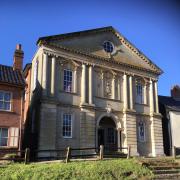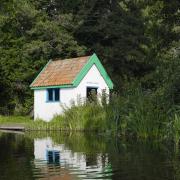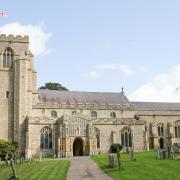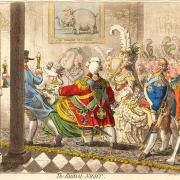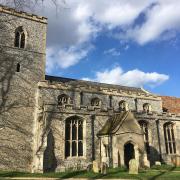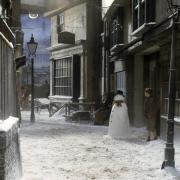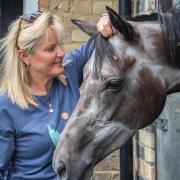Gruesome gallows hills, hell hounds and hauntings; witch-pits, poltergeists and ghostly apparitions… is the spooky Suffolk on your doorstep just a little too close to home at times?
Shady staircases with dancing orbs in Earsham; the gruesome stump of the Potsford gibbet-post still in situ near Wickham Market; a half-timbered Lavenham hotel room, just a few doors down from Harry Potter’s Godric’s Hollow, where a haunting housekeeper taps on a weird window in the dead of night...
Even in these days of global warming, Indian summers and mad heatwaves, Suffolk has an unsettlingly large crop of cold spots – but only if you dare go looking for them. Cooling sea-breezes and chilled-out corners of the coast aside, our ancient lands are riddled with tiny poignant patches, where sudden drops in temperature defy explanation, send shivers down the spine and positively spook us out.
And what more awesome time than autumn to screw your courage to the sticking place (you can thank Lady Macbeth for that advice), park your fears and get into ghostbusting mode? Go in search for tell-tale signs or rumours of spectres and from Bungay to Ballingdon, or Southwold to Stoke by Clare, you won’t be disappointed. Pubs, priory ruins, creepy crossroads, cottages and cliff tops; half-timbered houses and grand estates; gallows hills, mills, castles and coverts – outside and in, Suffolk has seek-out-or-side-step-worthy places galore, all reckoned to have stopped folk in their tracks over the years with inexplicable chilly blasts from the past. Tread carefully and who knows, you might feel an eerie body of cold air sidle up and momentarily go right through you. It could even hang about for hours... if you stay around long enough to find out.
Tune in to the fear frequency
Don’t feel the cold? Ah, but you could still be on the same wavelength. All Saints’ church at South Elmham, in north Suffolk’s ancient farmstead-dotted landscape known as The Saints, could be the place to find out. Park up and prepare to put your best foot boldly forward since only tiny country paths lead to this remote, redundant site. In summer, its wildlife sanctuary graveyard is absolutely buzzing, but inside, it’s quite a different story, whatever time of year you visit.
Cross the threshold. Shut the door behind you. And even if you can’t feel the coolness of the air, just listen. ‘Fear frequency’ infrasound (typically below 20Hz) isn’t something we’re consciously tuned into most of the time, but if or when we do, we might end up feeling uncomfortable or anxious, nauseous or ‘not alone’.
Believe some experts and you’ll put it down to man-made sources like traffic noise – hardly likely in The Saints – to the weather (really?), the earth itself (there are surely ley lines in these parts) and ‘other’ stuff (any offers?). Safe to say that after the first few creaks inside the church, when the building starts to speak to you in its own tongue, you’ll quickly get the picture... and probably make for the exit too. As for labelling the experience? Well, best leave that to you.
For more creepy stuff head to Roos Hall near Beccles, Grade I listed and said to be among the most haunted houses in England. On Christmas Eve, a phantom coach pulled by four horses pulls up outside carrying a headless man. Some strange phenomena inhabit one of the bedrooms; there's said to be a wardrobe that has the Devil’s footprints inside. Outside, in the woods, the restless spirits of some of those hanged there haunts the renowned ghost-ridden gibbet or Hanging Tree.
Over at Earsham Hall, meanwhile, faces peer through upstairs windows, heavy footsteps echo around empty rooms, tools go walkies from workshop to workshop and orb-like tricks of the light add a different trompe l'oeil dimension to the cool and creaky staircase. But these ghostly goings-on are never malevolent.
How to explain the inexplicable?

Practically every corner of Suffolk has bumps in the landscape (as well as in the night) whose stories or significance may be lost in the myths of time. Whole villages have history oozing through the floor boards, coming out of the woodwork and seeping through the disconcertingly ‘breathable’ lime plaster. Medieval folk called Suffolk ‘Seilig’ (pronounced ‘silly’), meaning ‘holy’ (think proliferation of churches and monastic sites), or are we talking spirit-ual here?
At St Mary’s Bungay, the mysterious Druid’s Stone sits right alongside the church where East Anglia’s devil dog, Black Shuck, once went on its fiery rampage, before wreaking havoc at Blythburgh and leaving his burning claw marks on Holy Trinity’s door for all to see to this day. Superstition once reigned supreme here and its legacies come back to haunt us.
Perhaps some places just seem to have far too many spooky secrets and tales of doom and gloom to be dismissed as uncomfortable coincidence. Was it fate, as well as Canon H R Wilkinson, that brought Oliver Cromwell’s head briefly to Melton near Woodbridge? It landed across the river from the contorted remains of Saxon ancestors on show at Sutton Hoo, and just a stone’s throw from Witchpit Farm and the gallows hill, ‘Mount Misery’. Tudor heretics were led to burn at the stake from the gaol by the village’s crossroads, and several centuries later, an unfortunate local nursed a nasty bite on his thumb from a ‘shuck-like’ beast until his dying day.
All mere superstition and Suffolk squit? Or should we tread carefully around Suffolk this Halloween and be sore afraid? Best play safe and not be too flippant. It could be unwise to make light of Suffolk’s dark, dreadful or ghostly goings-on, or adopt a devil-may-care attitude… in case he does.
Suffolk’s spookiest hot (and cold) spots

There are too many to mention, but here’s a quick cross-county round up. Elusive though spectres may be, you’ll know you’re getting warmer, when you feel that chill down your spine...
Bury St Edmunds – the place to be is The Nutshell. Spot mummified moggies and maybe ghostly monks in England’s tiniest pub. Wander the abbey ruins and discover the time-honoured tale of King Edmund’s murder and martyrdom. Don’t miss Moyses Hall Museum for its witch bottles, gibbet cage and gruesome remains and death mask of Polstead’s Red Barn murderer, William Corder.

Polstead – the prettiest of Suffolk villages, marked by a Victorian murder most foul. Take a walk via the half-timbered homes of the protagonists and maybe buy a souvenir pot of honey made at Maria Marten’s cottage to remind you of your visit and her sticky end.
Bungay – the Three Tuns Inn has a cold ‘hanging’ spot under the stairs and 24 ghosts, while the castle boasts the shade of Hugh Bigod. Or was Black Shuck his familiar? You’ll see the devil dog in all sorts of places here, from weather vanes to alleyways. Visit the priory ruins behind St Mary’s at dawn for a chance encounter with Katherine de Montacute in her embroidered medieval gown... or hear her humming a cheerful tune.

Sudbury – come face to face with Simon of Sudbury (d 1381) in St Gregory’s Church, the Archbishop of Canterbury-cum-Lord Chancellor decapitated by Wat Tyler in the Peasants’ Revolt. After West Suffolk Hospital radiographers scanned his skull, his full face was reconstructed, axe marks and all.
Brandon – look out for the ghost of barmy Baron Bliss by the mausoleum at Brandon Country Park. His party piece was to source human skulls and use them as tealights.

Dunwich – will you tune into the fear frequency and hear the bells of lost churches tolling beneath the waves, or see a hooded spectre amongst the remains of the priory?
Southwold – a backfiring canon left the ghost of a headless soldier to roam Gun Hill.
Snape – one unfortunate excise man had his nose cut off by unruly smugglers. Walk the Sailors’ Path towards Aldeburgh for the thrill (or chill) of the chase.
Long Melford – you’ll find the moving stories of disappearing stab-victim Richard Evered in a hotel here, and even a poltergeist or two, but both of the village’s stately homes also have haunting tales to tell.
Lowestoft – in the old town, Black Shuck is said to have raced up and down Rant Score and the witches stones in Belle Vue Park would roll down to the sea and back again.
Haverhill – the Great Fire here sent one of Suffolk’s finest weaving towns spinning into decline. Anne of Cleves House remains to tell the tale.
Ipswich – from the old White Horse in Tavern Street to The Rep, St Stephen’s Church, Christchurch Mansion and Ancient House, sightings of grey ladies and shady ghouls abound.

Framlingham – will you see the shades by the bailey or hear the ghostly horse-hooves by Ed Sheeran’s castle on the hill? The stocks and whipping post in the church porch of nearby Saxtead All Saints are an uncomfortable find too.
Brandeston – the village sign remembers octogenarian Rev John Lowes who found himself between the devil and the deep blue sea, confessed under duress to imploring an imp to brew up a ship-sinking storm off Harwich and ended up on the gallows.








